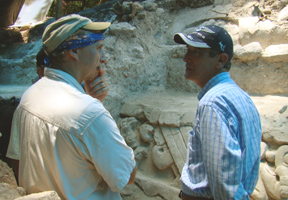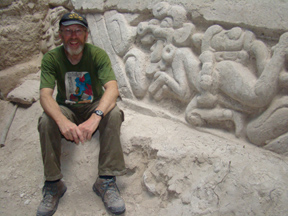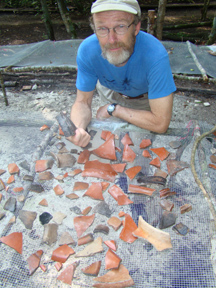Idaho State researchers help make major Mayan archaeological discoveries
March 10, 2009
Guatemala City, Guatemala – The government of Guatemala has announced the recent discovery of a series of major archaeological discoveries – including ancient detailed panels – in an area known as the Mirador Basin of northern Guatemala and part of southern Campeche, Mexico.
The area has been under extensive exploration and investigation for more than two decades by the Mirador Basin Project, directed by Richard Hansen, senior scientist in the Institute for Mesoamerican Research at Idaho State University and president of the FARES Foundation based in Idaho.
 The discoveries, announced March 7, include major finds in the ancient city of El Mirador and the newly discovered ancient city in the southern part of the Basin known as El Pesquero, Spanish for “The Fishermen.” The area, which was known anciently as the “Kan” (serpent) Kingdom, consists of about 810,000 acres of pristine tropical forest in northern Guatemala and contains a concentration of very large and early ancient Maya cities, dating to the Middle and Late Preclassic periods of Maya civilization, between about 1000 B.C. and A.D. 150.
The discoveries, announced March 7, include major finds in the ancient city of El Mirador and the newly discovered ancient city in the southern part of the Basin known as El Pesquero, Spanish for “The Fishermen.” The area, which was known anciently as the “Kan” (serpent) Kingdom, consists of about 810,000 acres of pristine tropical forest in northern Guatemala and contains a concentration of very large and early ancient Maya cities, dating to the Middle and Late Preclassic periods of Maya civilization, between about 1000 B.C. and A.D. 150.
Scholars have labeled the area as the “Cradle of Maya Civilization” because of the size, scale and antiquity of ancient Maya cities contained in the area. The Mirador Basin also is the heart of a major new conservation program called “Cuatro Balam” designed by Guatemalan President Alvaro Colom Caballeros to protect a substantial forested area of northern Guatemala’s Peten region.
The research and conservation program being conducted in the Mirador area is supported by the Global Heritage Fund of Palo Alto, Calif., a coalition of Guatemalan citizens known as APANAC, in Guatemala City, and perhaps most significantly, the formation of group of the most prominent Guatemalan companies and industries into a foundation known as PACUNAM to support the investigation and conservation of the Mirador area.
 The discovery at the site of El Mirador, which is considered the largest of all ancient Maya cities in Mesoamerica, consists of a detailed series of panels made of carved and modeled lime plaster that lined a water collection system in an area of the city known as the Central Acropolis. The panels and water collection tanks date to the Late Preclassic period, from 300 B.C. to about the time of Christ. Idaho State University student Joseph Craig Argyle, who has been investigating the water collection systems at El Mirador under the direction of Hansen, excavated the panels.
The discovery at the site of El Mirador, which is considered the largest of all ancient Maya cities in Mesoamerica, consists of a detailed series of panels made of carved and modeled lime plaster that lined a water collection system in an area of the city known as the Central Acropolis. The panels and water collection tanks date to the Late Preclassic period, from 300 B.C. to about the time of Christ. Idaho State University student Joseph Craig Argyle, who has been investigating the water collection systems at El Mirador under the direction of Hansen, excavated the panels.
The panels, which flank the series of pools of a unique water control system that included the capture of rainwater from surrounding massive architecture, depict two “swimming” individuals that are framed by cosmic monsters of importance in ancient Maya art. “We tentatively believe that the ‘swimmers’ represent the Hero Twins of the Popol Vuh,” said Hansen, referring to the Quiche Maya text of the Maya creation story, which was found in the highland town of Chichicastenango in A.D. 1700 and transcribed by a Dominican monk named Francisco Ximenez by about 1704.
“One of the swimmers has a decapitated head on his flanks, which is likely the decapitated head of his father, who was known in Maya mythology as Hun Hunahpu.” The other swimmer has a headdress with jaguar features, which would possibly associate him with his twin brother, known as ‘Xbalanque’ (Young Jaguar Sun), according to Hansen.“This suggests that the antiquity of the Popol Vuh as an authentic creation story extends far into the Preclassic eras,” said Hector Escobedo, vice minister of Culture in the Guatemalan Ministry of Culture. Additional upper panels of the water frieze show what appears to be an undulating serpent, which frames Deity images of an old man with wings.

“All in all, the scene is a complex blend of early Maya mythology and cosmology,” said Hansen.
Another important discovery was made in the southern part of the Mirador Basin by a team from the Guatemalan Institute of Anthropology and History and the Mirador Basin Project, supervised by project co-director Hector Mejia. Looters had penetrated the upper portion of a large mound and had revealed the remains of an ancient roof comb, which is a decorative panel on the summit of a pyramid structure. Excavations, stabilization, and consolidation of the art and architecture by the Mirador Basin project indicated that the roof comb was also unusually early, consistent with other sites in the area.
“The Pesquero structure is of extraordinary importance,” Hansen said, “because it indicates that many of the features commonly thought to be unique to the great Classic periods of Maya history (A.D. 300-A.D. 900) extend well into the Middle and Late Preclassic periods of Maya history, from by about 800 B.C. to the time of Christ.”
For more information on Mirador Basin scientific discoveries and the efforts to conserve this extraordinary area, please see the accompanying side bar, or visit www.miradorbasin.com.
Guatemalan Government Cuatro Balam Conservation Plan
Is New Effort to Protect Mirador Basin
Guatemala City, Guatemala – The area of the proposed new conservation plan of Cuatro Balam is a major new effort by the Guatemalan government to curb the rampant deforestation, logging, narcotics trafficking, poaching, looting and seemingly endless poverty by including the communities in a truly sustainable model based on conservation and tourism.
The Kan Kingdom/Mirador Basin forms the heart of the Cuatro Balam conservation program, as announced by Guatemalan President Álvaro Colom Caballeros, in his inaugural address last year.
“The Kan Kingdom was unique in world history,” says Richard Hansen, senior scientist in the Institute for Mesoamerican Research at Idaho State University and president of the FARES Foundation based in Idaho, “because of the concentration of such large and early centers that were connected by a latticework of ancient causeways, forming what we believe to be the first economic and political state level society in the Western Hemisphere.”
While some sites in North America, such as Poverty Point and Watson Break in Louisiana, and the Caral site in Peru have sites with important monumental architecture that date to an earlier period, they do not exceed the size, scale and sophistication of the early sites in the Mirador Basin, according to Hansen.
The Mirador Basin sites are among the largest in the Western Hemisphere, with art and architecture dating to at least 1000 years earlier than the better-known Classic sites such as Tikal, Palenque and Copan.In addition, the sites contain structures that rank among the largest ancient pyramids in the world. The area also contains an extensive network of ancient causeways or highways, representing what Hansen terms is the “first freeway system” in the world.
Furthermore, the area is the last intact area of tropical rainforest left in Central America and efforts to protect it have allowed Hansen to be recognized as the “Environmentalist of the Year for Latin America, 2008” by the Latin Trade Bravo Business association, based in Miami.
Movie star Mel Gibson has been an active proponent for its conservation as the Chairman of the Board for the FARES Foundation. “It (the Mirador area) is arguably the greatest archaeological find in the Western Hemisphere. For 30 years, Dr. Richard Hansen has worked with unparalleled commitment and passion to bring to light these awe-inspiring discoveries,” said Gibson recently at the Latin Trade Awards for Excellence in Miami. “Richard has created a new model for rainforest and archaeological site conservation through sustainable programs using the ancient jungle shrouded cities as the economic catalysts for their own preservation.”
What makes the project unusual is the blend of the private and public sectors that are mounting a major effort to investigate and conserve the area. The vision that President Colom and other government authorities are providing, together with the private sector, is to provide a more viable and sustainable program through active conservation, responsible development, a strengthened security system and economic opportunities through training and involvement of communities in tourism programs.
For more information on this area visit www.miradorbasin.com.
Categories:
